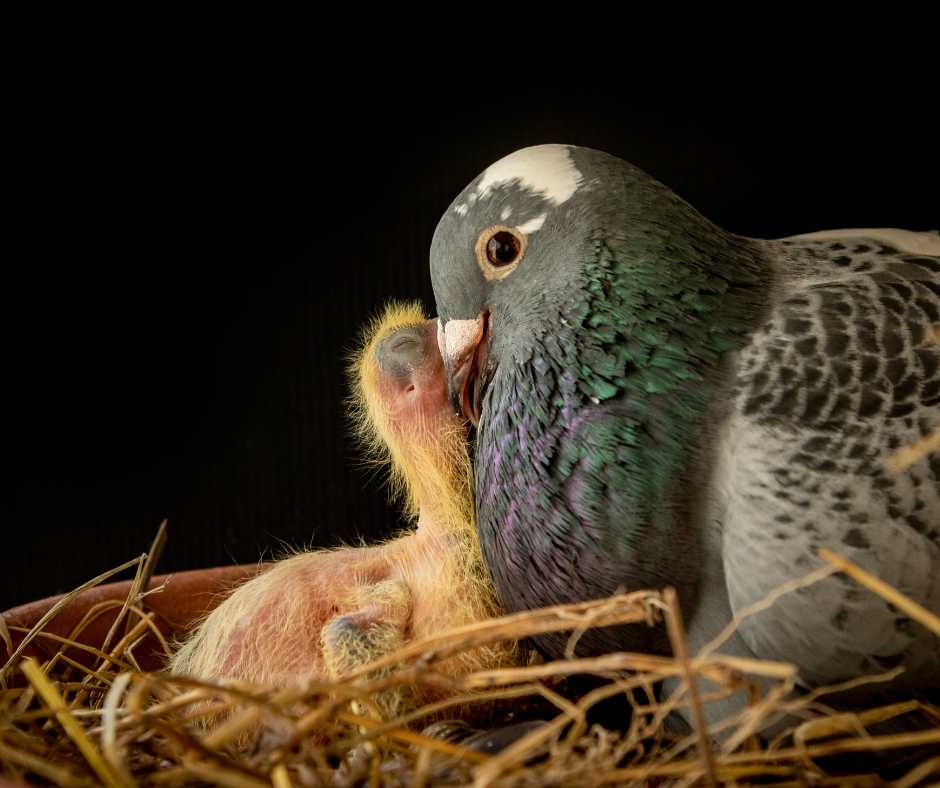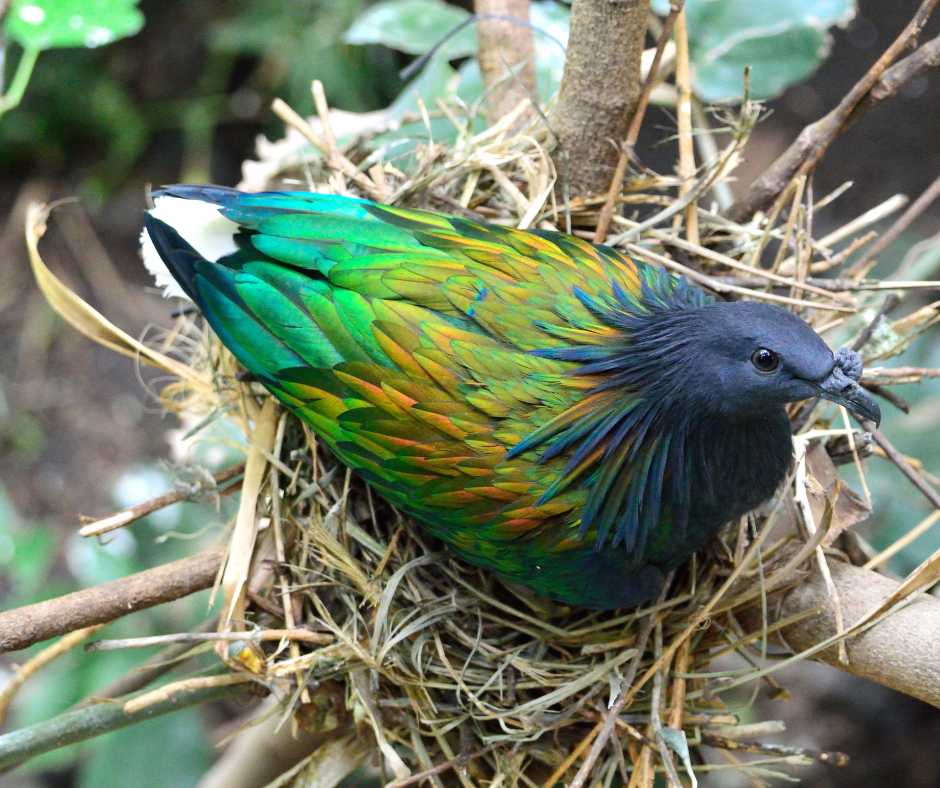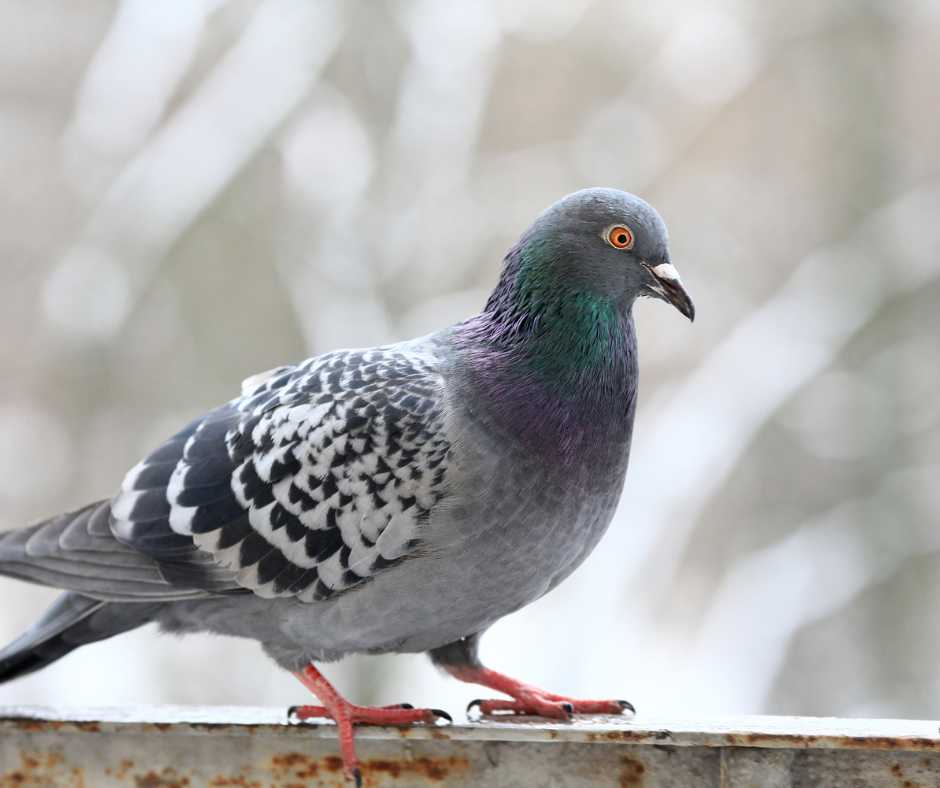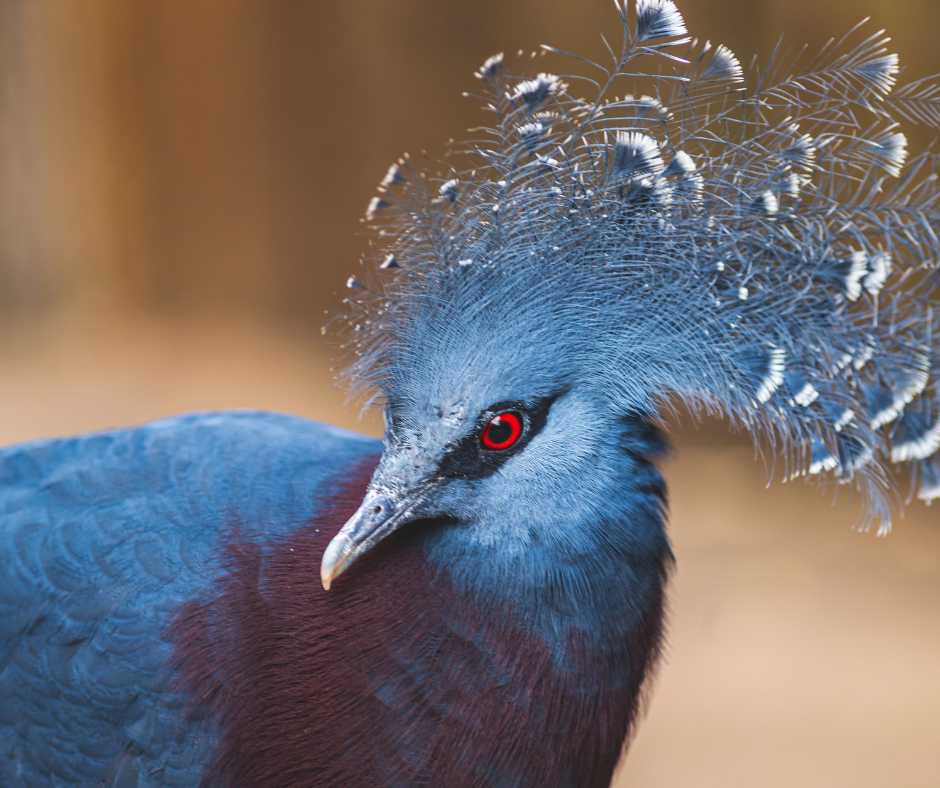Did you know pigeons can recognize themselves in mirrors? While these urban companions are marvels of adaptability, they’re often misunderstood and labeled as nuisances. Many people view pigeons merely as city background noise, unaware of the challenges they face and their ecological contributions.
This blog aims to shed light on pigeon nesting, debunking common misconceptions, and showcasing their role in urban biodiversity. From innovative nest construction to overcoming predators and human conflicts, join us as we gain a newfound respect for these adaptable urban dwellers.
| Aspect | Details |
| Seasonality of Nesting | With multiple broods, year-round nesting ability is possible due to abundant food and suitable nesting spots. |
| Nesting Site Selection | For safety and resource proximity, preference for urban structures reminiscent of ancestral cliff-side origins, like building ledges and under bridges. |
| Nest Construction | Made from twigs, leaves, and urban debris, nests become sturdier with pigeon droppings acting as a natural cement. |
| Nest Function | Serves as fortresses, elevated to protect from predators and designed to safeguard eggs and chicks from environmental elements. |
| Breeding | Pigeon species exhibit varied breeding strategies; Rock Pigeons have flexible breeding cycles in urban environments, while Wood Pigeons breed seasonally. Tropical species may breed year-round, showing adaptability across different environments. |
| Egg Laying & Incubation | On average, two eggs are laid, with both parents sharing incubation duties to ensure constant warmth and protection until hatching. |
| Chick Rearing | Starts with feeding protein-rich “pigeon milk,” then gradually transitioning to solid foods around ten days old, preparing chicks for independence. |
| Urban Survival Challenges | Despite facing predators and human-pigeon conflicts, pigeons adapt and thrive in urban settings. |
Understanding Pigeon Nesting Behaviors
Ever noticed pigeons making themselves at home in our concrete jungles and wondered, “What’s their deal?” Let’s explore the world of pigeons, focusing on their nesting practices, and reveal some hidden facts about them!
The Seasonality of Pigeon Nesting
Pigeons don’t wait for a specific season to start their families. They’re year-round nesters, thanks to their incredible adaptability. They’re good to go as long as there’s enough food and a cozy spot. This means pigeons can have multiple broods in a year, making them one of the most resilient urban dwellers.
Choosing the Ideal Nesting Site
When pigeons pick a place to nest, they’re not just looking for real estate with a view. They crave spots that remind them of their cliff-side origins, like ledges on buildings or spaces under bridges. Why the high-up spots, though? Safety first! Being up high keeps them out of reach from predators, and if there’s food and water nearby, even better.

So, the next time you spot a pigeon nest perched up high, remember that it’s all about survival, safety, and a touch of ancestral homage. These city birds have figured out how to make the most of urban living, blending the old with the new in their quest for the perfect home.
The Architecture of Pigeon Nests
Imagine if you had to build your house with just what you find around you. Sounds harsh, right? Well, pigeons are the champs of doing just that. They’re the DIY masters of the bird world, creating cozy spots out of twigs, leaves, and pretty much any scraps they can scavenge. Let’s look at how they put together their humble abodes.
Materials and Construction of Pigeon Nests
Pigeons aren’t picky builders. They grab sticks, leaves, and even bits of plastic to craft their nests. Think of it like building a fort out of blankets and pillows, but with whatever’s lying around. Starting with a flimsy base, they work their magic to create a saucer-shaped nest.
Now, here’s where it gets interesting: pigeon nests get an upgrade from an unexpected source—pigeon poop. Yes, their droppings act like cement, making the nest stronger and more durable over time. Talk about recycling!
The Structure and Function of Pigeon Nests
You might wonder, why do pigeon nests look so simple? Well, it’s all about function over fashion. These nests aren’t just beds; they’re fortresses.
Positioned high up, they’re safe from most predators, and their sturdy design protects the eggs and chicks from the elements. Each nest is a testament to the pigeon’s survival skills, proving that sometimes, simplicity is the ultimate sophistication.

Diverse Breeding Seasons Across Pigeon Species
Pigeons come in many types, and they change when they have babies based on where they live and what challenges they face. Let’s see how different kinds of pigeons have babies at various times to do well in their homes.
Rock Pigeons: The Flexible Ones
Rock pigeons, the ones we see all the time, don’t have a set time for having babies. They can have babies several times a year because they find enough food and safe places to make their nests in the city. This way, they can live well in cities, having babies whenever the conditions are right.

Wood Pigeons: The Spring and Summer Babies
On the other hand, wood pigeons that live where the seasons change have their babies in spring and summer. It is when there’s a lot of food for their chicks, like seeds and plants, from April to September. They use this time when food is plenty to raise their little ones.
Tropical Pigeons: All-Year Round
Pigeons can have babies anytime in places where it’s warm all year, and food is always around, like the Pink-necked Green Pigeon in Southeast Asia. They’re lucky because they always have fruits to eat, so they don’t have to wait for a specific season.

Traveling Pigeons: Timing with Travel
Some pigeons used to travel from place to place. The Passenger Pigeon, which isn’t around anymore, had babies in spring and early summer in the north before moving south for the winter. They had to plan their baby-making around their travel schedule.
Mountain Pigeons: Waiting for Warmth
Pigeons living up high where it’s cold must wait for warmer months to have babies. They need it to be warm enough for water to be liquid and food to be available. So, they usually pick the warmer times of the year to start their families.
Egg Laying and Incubation Strategies
Pigeon parents are the ultimate team players. When it’s time to start a family, they typically lay two shiny white eggs, each about the size of a large marble. It is where teamwork kicks in.
Both mom and dad pigeons take turns incubating the eggs, ensuring they receive constant warmth. This tag-team approach ensures that the eggs are always under the protective watch of at least one parent, day and night until it’s time for them to hatch.
Rearing the Next Generation
The Critical Role of Pigeon Milk
After the big hatch day, pigeon parents shift gears to feeding their hungry chicks with something pretty extraordinary called “pigeon milk.” Despite its name, pigeon milk isn’t dairy but a nutrient-rich fluid both parents produce. This superfood, rich in proteins and fats, is crucial for the rapid growth of the newly hatched chicks, ensuring they get the best start in life.
Transitioning to Solid Foods
As baby pigeons get more significant, what they eat starts to change. When they’re about ten days old, they begin trying out solid food, moving away from just having pigeon milk. It’s like how human babies go from drinking just milk to trying different foods.
Pigeon parents slowly help their babies learn to eat the same food grown-up pigeons eat. This change helps baby pigeons grow strong and prepares them to care for themselves, teaching them what they need to know to live in the city.
Raising pigeons is a big job that shows how hardworking and flexible these city birds are. From keeping their eggs warm to showing their young ones how to find food, pigeon parents work together every step of the way. So, when you see a pigeon next time, remember all the hard work they do to bring up their babies.
Navigating Challenges
With their sleek feathers and cooing sounds, Pigeons might seem like they’ve got city living all figured out. But, just like superheroes have their kryptonite, pigeons face their challenges in the urban jungle.
Predators and Urban Dangers
You’d think the city would be a haven for pigeons, far away from the forest’s predators. Yet, the city brings its own dangers. Sneaky cats lurking in the shadows, rats that don’t play fair, and even hawks that soar between skyscrapers can turn a pigeon’s day from chill to thrill in seconds.
Pigeons must keep their eyes peeled and their wings ready to dodge these urban predators. They’re like the ninjas of the bird world, always on guard to protect their little ones nestled in the high-rise homes they’ve built.
Human Interactions and Conflicts
Now, let’s talk about us—humans. Our relationship with pigeons is… complicated. While some of us throw breadcrumbs and admire their city-slicking ways, others see them as uninvited guests, calling them names like “flying rats.” Ouch, right? This love-hate relationship can make life challenging for pigeons.
Our buildings remove their natural homes, and then we shoo them away when they try to adapt. But here’s the thing: pigeons aren’t looking to crash our party; they’re just trying to survive in the hustle and bustle we both call home.
So, what can we do to live in harmony? It starts with understanding. Recognizing that pigeons, like us, are just trying to make the best of their surroundings can help us find ways to coexist peacefully.
Simple things like keeping our food scraps to ourselves (because, let’s face it, too much human food isn’t good for them) and respecting their nesting spaces can make a big difference. After all, sharing the city with these feathered residents adds a bit of nature to our concrete world, reminding us of the wildness we come from.
Navigating city life is no small feat for pigeons. Still, with some empathy and understanding from humans, we can all flap our wings in harmony, making the urban jungle a little friendlier for everyone.

Pigeon Nesting in Urban Landscapes
City life isn’t just for the hustle and bustle of humans; pigeons have carved out a pretty nifty existence amongst the concrete and chaos, too. Let’s zoom in on how these feathery folks have become the ultimate city dwellers.
Adapting to the City Life
Pigeons have taken “make it work” to a whole new level. They’ve swapped out the natural cliffside condos of their ancestors for our urban architecture without skipping a beat. Buildings, bridges, and balconies have become the new nesting hotspots. And you know those leftovers you didn’t want?
Well, pigeons aren’t picky eaters; our scraps are their treasure. They’ve gotten so good at navigating the city that finding food and a place to crash is a walk in the park (or a fly over the city) for them. This adaptability has allowed them to survive and thrive in environments made by humans for humans.
The Importance of Pigeon Nesting to Urban Biodiversity
Now, you might think, “What good are pigeons in the city, anyway?” Turns out, they’re doing more than just decorating our sidewalks. Pigeons play a pretty cool part in keeping our urban ecosystems balanced.
By munching on pesky insects and occasionally spreading seeds, they’re doing us a solid without us even realizing it. Think of them as the city’s unsung heroes, taking care of the little things so we can worry about the bigger ones.
So, next time you see a pigeon nest tucked away in the corner of a building, remember, it’s not just a pile of twigs—it’s a sign of nature adapting and thriving alongside us in the concrete jungle. Pigeons remind us that even in the busiest of places, life finds a way to flourish.

People Also Asked
Can pigeons nest anywhere in the city?
Pretty much! Pigeons are pretty picky and can make a home anywhere from a busy street corner to the top of a skyscraper.
How long do pigeon eggs take to hatch?
Pigeon eggs usually hatch after about 18 days of being cozy and warm under their parents.
What should I do if I find a pigeon nest?
It’s best to leave it be. Pigeon families are pretty self-sufficient, and disturbing their nest could cause them stress.
Do pigeons return to the same nest?
Yes, pigeons are creatures of habit and often return to the same spot to nest repeatedly.
How can we help pigeons in our cities?
Simple things like providing clean water and not disturbing their nests can make a big difference in their lives.
Wrap Up
So, the next time you see a pigeon, remember that there’s more to these city birds than meets the eye. They’re not just visitors but residents, architects, and parents doing their best to survive in the urban wild. Let’s give them a little respect and a bit of love. After all, pigeons are pretty cool once you get to know them.
Useful Resources:
- Cornell Lab of Ornithology’s All About Birds: This site offers comprehensive details on various pigeon species, including behaviors and ecology, which can enrich understanding of pigeon adaptability and nesting habits. – All About Birds
- National Geographic: An excellent resource for exploring the intelligence of pigeons, including their ability to recognize themselves in mirrors, which can help debunk misconceptions about these birds. – National Geographic – Pigeon Intelligence
- Audubon Society: Provides insights into the role pigeons play in urban biodiversity, highlighting the importance of these birds in maintaining ecological balance within cities. – Audubon Society
- Animal Diversity Web (University of Michigan): Contains detailed species profiles for pigeons, including breeding habits, diet, and nesting behaviors, providing a scientific foundation to the content. – Animal Diversity Web – Pigeons
- The Royal Society for the Protection of Birds (RSPB): Offers guidance on how to coexist with pigeons in urban areas, including how to manage and appreciate their presence. – RSPB – Living with Pigeons

